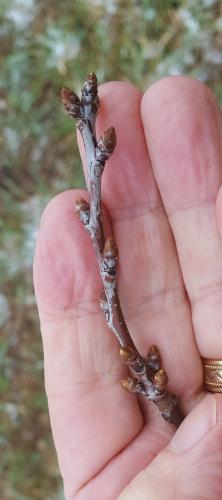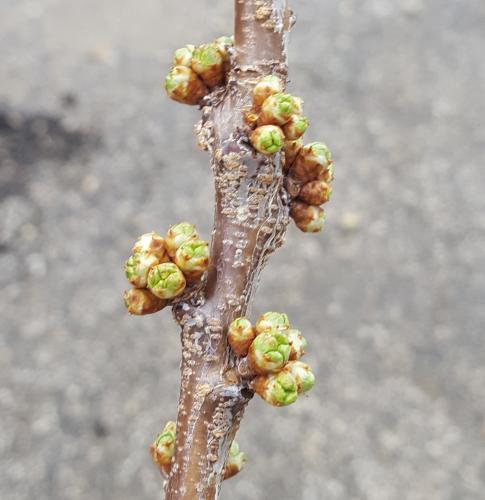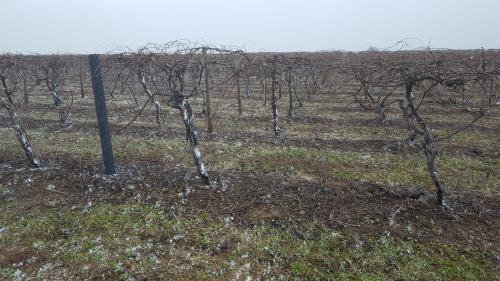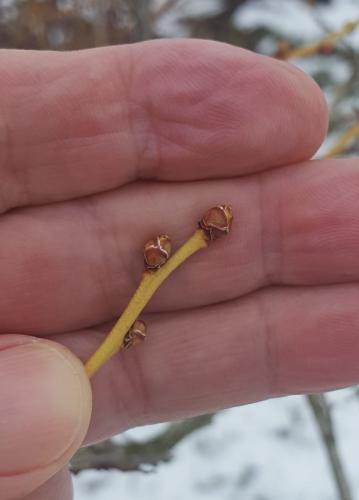Southwest Michigan fruit update — April 17, 2018
A wintry blast over the weekend did not cause any damage. Plant growth is just beginning, waiting for warm temperatures to return later in April.

Weather
Temperatures for the first week of April were cold with highs in the 30s and 40s and lows in the 20s and teens. Last week was warmer. Temperatures rose into the 50s and 60s with lows above freezing and into the 40s. We saw the first bud movement since early March. We should see green growth in southern areas by the end of the week.
A cold front parked over the region last weekend bringing rain, freezing rain, frozen rain, ice and finally snow. Colder than normal weather is forecast to continue for the week, with highs in the 40s rising into the 50s. Low temperatures for the week will be near freezing. These cold temperatures, about 10 degrees below normal, will continue to slow normal spring development.
|
Southwest Michigan GDD summary from Jan. 1 – April 15 2018 | |||
|---|---|---|---|
|
Station |
GDD 42 F |
GDD 45 F |
GDD 50 F |
|
Benton Harbor (SWMRC) |
111 |
73 |
28 |
|
Lawton (Lawton) |
109 |
76 |
30 |
|
Fennville (TNRC) |
82 |
50 |
18 |
|
Average for the SW region |
111 |
71 |
18 |
|
Southwest Michigan GDD summary from March 1 – April 15 2018 | |||
|---|---|---|---|
|
Station |
GDD 42 F |
GDD 45 F |
GDD 50 F |
|
Benton Harbor (SWMRC) |
48 |
30 |
11 |
|
Lawton (Lawton) |
46 |
29 |
11 |
|
Fennville (TNRC) |
29 |
15 |
4 |
|
Average for the SW region |
49 |
30 |
11 |
|
Accumulation last week |
28 |
20 |
10 |
In general, fruit growers continue to be pleased that the cold weather has held back bud development. Delayed development reduces the likelihood of damaging spring freezes during bloom by pushing bloom later and later to when the possibility of damaging freezes is very small. The forecast for the upcoming week is for continued cold with lows around freezing. A warmup over the weekend with highs climbing to around 60 is followed by continued warm weather.
Tree fruit
Continued cool temperatures are holding tree fruit development back, but are not low enough to cause any damage. At this time, most fruit crops are still in the swollen bud to first green stages—development is more advanced closer to the Indiana border (see “Freeze damage depends on tree fruit stage of development”).
Recent rains have slowed ground preparation, spraying, fertilizing and tree planting activity, especially for heavier soil sites. Some oil sprays for scale went on late last week. Growers should check blocks for evidence of San Jose scale on branches to determine the need for oil sprays.

These ‘Montmorency’ tart cherry buds are beginning to swell.
Apricots are in red calyx.
Peach and nectarine fruit buds are noticeably swollen. Long episodes of wetting and temperatures above 50 degrees Fahrenheit favor bacterial spot. Temperatures have been too cool and wetting periods too short for peach leaf curl infections. However, fungicide coverage is still needed for future infection events. Temperatures have generally been too low for bacterial spot multiplication on twigs. Low level of copper help to suppress bacterial populations.
Sweet cherry bud swelling is evident. Montmorency tart cherry fruit buds are still relatively tight. We are still in the window when copper sprays can be applied to sweet cherries. Copper applications may reduce bacterial canker in cherries.
Japanese plum varieties are at swollen bud to early bud burst. European plum fruit buds are swelling. Thorough pruning out of black knot and disposal of the knots by burning is an important step in managing this disease.

Green tip is the name of bud burst in plums. These green tip buds are from ‘Simka’, an early Japanese plum.
Apples are starting to show fruit bud swelling with first green showing on early developing varieties such as Idared and Zestar in some sites. Scab ascospores were caught in relatively low numbers in two trapping sites in southwest Michigan over the past week. The current cool temperature has allowed scab ascospores to mature ahead of tree development. Copper sprays are useful for early scab control and fire blight suppression.
Pear fruit buds are at bud swell.
Small fruit
Grapes have not yet begun growth. There is plenty of time to apply dormant sprays to reduce powdery mildew and other diseases.

This mechanically hedged vineyard of ‘Niagara’ is still dormant with no bud movement.
Blueberry flower buds are only slightly swollen. Leaf buds have not moved. Warmer weather next week will bring growth, making them susceptible to mummy berry infections. Many growers have already applied dormant sprays of copper, Sulforix or lime sulfur products to suppress early season diseases.

Blueberry flower buds are swollen but have not yet burst.
Strawberries have greened up, but new leaves are not emerging from the crown. Overwintering mulches should be removed and raked between the rows. Growers are looking at early season herbicides to control overwintering weeds.
Brambles show little movement. Dormant pruning should be completed. In summer bearing raspberries, last year’s primocanes should be headed (cut back) to the desired height and any floricanes removed. Fall bearing raspberries should be cut or mowed to the ground. Lime sulfur treatments for anthracnose can still be applied.
Upcoming meetings
Our regular Monday fruit IPM meetings have started. The next meeting is April 23 at Fruit Acres Farms, 3452 Friday Rd, Coloma, MI at 5 p.m. Two Michigan RUP applicator recertification credits are available at these meetings.
Related articles
- Freeze damage depends on tree fruit stage of development
- 2013 bloom dates for southwest Michigan tree fruit crops
- Do you need to worry about early spring freezes?
- Probability of a hard frost or freeze in the spring for some southwest Michigan fruit sites
- Early start to the growing season means early start to disease control in fruit crops
- Treat peach leaf curl now.
- Managing bacterial canker in sweet cherries: What are the options?
- Early insect control with horticultural oils
- Dormant oil for tree fruit pest management in 2015
- It’s not too late for dormant sprays in grapes
- Dormant sprays for disease control in blueberries
- The blueberry mummies return! Here’s how to be prepared



 Print
Print Email
Email




